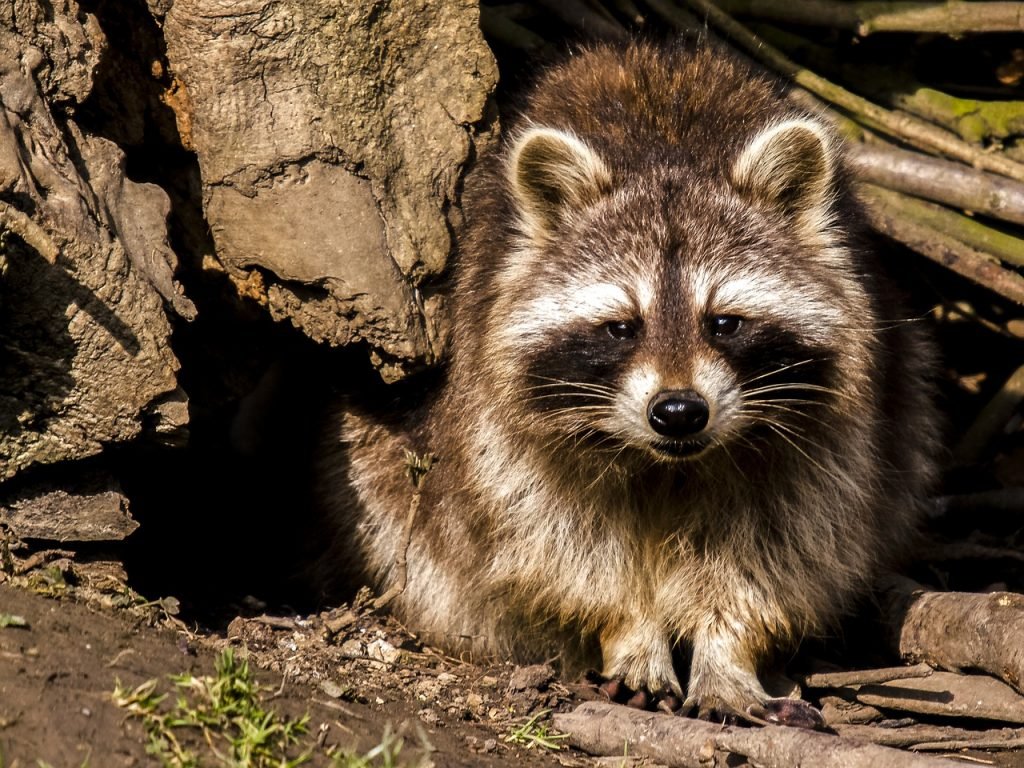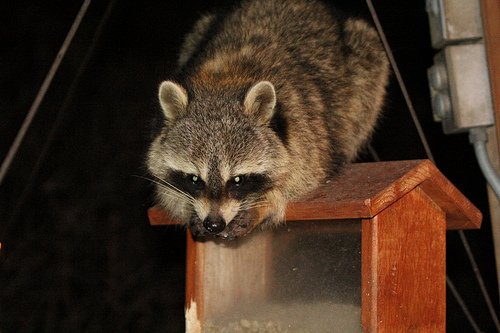How To Identify Raccoon Poop?

Even if you couldn’t identify which animal’s poop it was, chances are you’ve seen raccoon feces. Most raccoon feces are tubular in shape and reach a maximum length of three inches. It can, however, have a clumpy and sticky appearance. Raccoon droppings usually a dark black color, but it can also appear brown.
Other telltale signs vary depending on where you live. They scavenged crayfish, berries, and other items from discarded human food sources such as dumpsters and trash cans. In some cases, it almost gives the droppings a speckled appearance.
When compared to other types of animal feces, we’d say raccoon feces is among the most disgusting you’ll find in the woods or inside your house. Different areas are effectively designated as restrooms by raccoons. They’re known as raccoon latrines by biologists.
Raccoons will occasionally decide to use human attics as toilets, which can be a problem if they poop in your crawl spaces, haylofts, on your deck, roof, or your child’s swing set. Because of the health risks involved, you should take an infestation like this very seriously.
Common Locations Of Raccoon Droppings
 Raccoons defecate in latrines, which are communal bathrooms. Raccoon feces are typically dark and tubular, with a strong odor. Latrines can be found at or on the following locations:
Raccoons defecate in latrines, which are communal bathrooms. Raccoon feces are typically dark and tubular, with a strong odor. Latrines can be found at or on the following locations:
- Raised Surfaces (Roofs, Tree Houses, Etc)
- Forested Areas With Heavy Foliage
- Ontop Of Garage And Inside Garage Attics
- Ontop And Below Decks/Patios
- Inside Attics
Dangers Of Raccoon Feces
Infectious diseases are known to be carried by raccoons in the United States, which can be transmitted to humans and animals who come into contact with them or their waste. Diseases commonly found in the still of raccoons include Roundworm, Salmonella, and Giardiasis. Raccoons, both young and old, can shed viruses, bacteria, and parasites that can cause infections and disease in humans and animals. Raccoons and their waste should not be handled without proper protection and training. 1Go To Source dem.ri.gov -“Infectious Diseases of Raccoons”
Raccoon Roundworm
 The raccoon roundworm (Baylisascaris procyonis) is a large roundworm or ascarid that lives in the raccoons’ small intestine. Adult worms are 15 to 20 centimeters long and 1 centimeter wide. They have a tan-white color, are cylindrical in shape, and taper at both ends.
The raccoon roundworm (Baylisascaris procyonis) is a large roundworm or ascarid that lives in the raccoons’ small intestine. Adult worms are 15 to 20 centimeters long and 1 centimeter wide. They have a tan-white color, are cylindrical in shape, and taper at both ends.
The spread of B. Procyonis can happen directly or through an intermediary host. Raccoons that are naturally infected shed eggs in their feces. If the temperature and humidity are right, larvae will develop within the egg (embryonated) and be infective in 11-14 days. Accidental ingestion of these eggs causes infection in raccoons, especially young ones. This could happen as a result of the mother’s egg-contaminated body or the den’s local environment. When an intermediate host is present, embryonated eggs are consumed, the eggs hatch and the larvae pass through the intestines, liver, and lungs. The larvae then enter the pulmonary veins, pass through the left side of the heart, and spread throughout the body, particularly in the head, neck, and thoracic areas. 2Go To Source michigan.gov -“Raccoon Roundworm (Baylisascaris)”
Salmonella In Raccoon Feces
Another common threat found in raccoon feces is salmonella. It is transmitted to humans through accidental ingestion, most commonly while moving one’s hands to the mouth. Unfortunately, this virus can lie dormant for an extended period of time.
It may only become active after a change in environment, such as moving to a new host. The host experiences a new range of symptoms due to this change, including high fever, severe diarrhea, and abdominal pain. Treatment usually results in a quick recovery, but in severe cases, hospitalization is required.
Raccoon Giardiasis
 Giardia intestinalis is a one-celled, microscopic protozoan that causes raccoon giardiasis. Infected people or animals’ intestines contain the parasite, which is passed in large numbers in the stool. The parasite has an outer shell that protects it from the elements and allows it to survive outside the body for long periods of time. Giardiasis is a parasitic infection found all over the world but is especially prevalent in warm climates. In a wide range of species, it causes diarrhea. 3Go To Source cfsph.iastate.edu -“Giardiasis”
Giardia intestinalis is a one-celled, microscopic protozoan that causes raccoon giardiasis. Infected people or animals’ intestines contain the parasite, which is passed in large numbers in the stool. The parasite has an outer shell that protects it from the elements and allows it to survive outside the body for long periods of time. Giardiasis is a parasitic infection found all over the world but is especially prevalent in warm climates. In a wide range of species, it causes diarrhea. 3Go To Source cfsph.iastate.edu -“Giardiasis”
What Does Raccoon Poop Smell Like?
Raccoons have very strong-smelling urine that can sometimes be detected from inside the house, not to mention their foul and strong-smelling feces. If a large amount of raccoon feces has accumulated, odors can be detected by residents through walls and ceilings. If a pungent odor that smells like ammonia is present, raccoons have likely created a latrine inside your home.
Raccoon Dropping Decontamination Process
Raccoon control professionals begin by vacuuming up all of the raccoon poop with wildlife-specific equipment to keep the dust particles contained and from becoming airborne. They then focus on removing urine after the feces have been removed. Raccoon cleanup technicians use bacteria-destroying chemicals to neutralize the urine. Once the infected area is dropping and urine-free, it will be treated to eliminate any odors left behind.
What Should I Do If Raccoon Feces Is Found In My Home?
“I found raccoon feces; what should I do?” is one of the most common questions posed by homeowners dealing with a raccoon infestation.
Given the health risks associated with having raccoons on your property for an extended period of time, it’s critical to act quickly and decisively if the animals enter your home or invade your property. Contact a wildlife removal company right away if raccoon poop is discovered.
Any qualified wildlife technician can not only remove the animals from your home but also clean and disinfect them to remove any disease-causing feces that may have been left behind. With this in mind, if you find yourself dealing with raccoons, contact Animals Happen immediately to ensure your peace of mind and health are not jeopardized.
Sources:
- “Infectious Diseases of Raccoons.” Dem.Ri.Gov, www.dem.ri.gov/programs/bnatres/agricult/pdf/raccoons.pdf. Accessed 14 July 2021.
- “DNR – Raccoon Roundworm (Baylisascaris).” Michigan.Gov, www.michigan.gov/dnr/0,4570,7-350-79136_79608_85016-27261–,00.html. Accessed 14 July 2021.
- “Giardiasis.” Cfsph.Iastate.Edu, www.cfsph.iastate.edu/FastFacts/pdfs/giardiasis_F.pdf. Accessed 14 July 2021.
